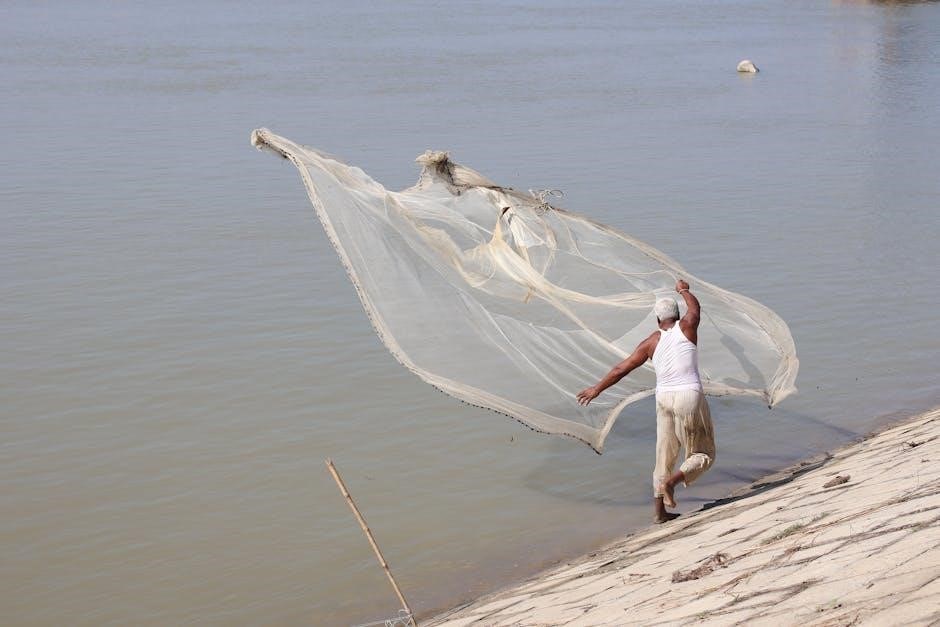The River by Gary Paulsen: A Comprehensive Overview
Gary Paulsen’s “The River” is a sequel to “Hatchet‚” continuing Brian Robeson’s survival journey. Following his initial wilderness experience‚ Brian returns‚ this time with a psychologist. Readers interested in exploring Brian’s next adventure can often find “The River” in PDF format online‚ providing accessible reading.
Gary Paulsen’s “The River” revisits Brian Robeson’s compelling narrative after his initial survival in “Hatchet.” This sequel delves deeper into the themes of resilience and the transformative power of nature. “The River” presents a new challenge for Brian‚ marking a significant chapter in his coming-of-age story. The book’s enduring appeal lies in its exploration of human adaptability and the profound connection between individuals and the wilderness;
For those eager to experience Brian’s renewed adventure‚ “The River” is frequently available in PDF format. This accessibility allows readers to readily engage with Paulsen’s vivid storytelling and explore the novel’s rich themes. The story follows Brian’s return to the wild‚ accompanied by Derek Holtzer‚ a psychologist researching survival techniques. The narrative underscores the importance of decision-making and self-reliance in extreme circumstances.
Paulsen’s writing masterfully captures the essence of the wilderness‚ creating an immersive reading experience. The availability of “The River” as a PDF ensures that a wide audience can access this powerful tale of survival and personal growth. The novel offers a unique perspective on the challenges and rewards of confronting nature’s raw power and the human spirit’s capacity to endure.
Brian Robeson’s Return to the Wilderness
In “The River‚” Gary Paulsen revisits Brian Robeson‚ thrusting him once more into the unforgiving embrace of the wilderness. This time‚ Brian’s return isn’t born of accidental isolation‚ but rather a deliberate expedition. He agrees to accompany Derek Holtzer‚ a psychologist studying survival‚ back to the wild. Brian’s prior experiences‚ detailed in “Hatchet‚” have transformed him‚ equipping him with invaluable knowledge and resilience.
However‚ this return is far from a simple repeat of his previous ordeal. “The River” explores how Brian’s understanding of the wilderness has evolved‚ testing his skills and forcing him to confront new and unexpected challenges. The availability of “The River” in PDF format allows readers to easily access and analyze Brian’s transformation. The wilderness serves as both a testing ground and a place of profound personal discovery for Brian. His decision-making‚ honed by past experiences‚ becomes crucial for his and Derek’s survival.
The narrative explores the psychological impact of prolonged exposure to the wild‚ highlighting the delicate balance between human ingenuity and nature’s power. Paulsen’s vivid descriptions and compelling character development make Brian’s return to the wilderness a captivating and thought-provoking read. The PDF version of “The River” offers a convenient way to delve into this adventure.
Plot Summary of The River

“The River” by Gary Paulsen picks up Brian Robeson’s story after his initial survival experience in “Hatchet.” Brian‚ now more experienced‚ agrees to a government request to revisit the wilderness with Derek Holtzer‚ a psychologist aiming to learn from Brian’s survival skills. Their journey begins smoothly‚ but disaster strikes when a lightning storm incapacitates Derek‚ leaving Brian to fend for them both.
Brian must navigate the treacherous river to seek help‚ utilizing the skills he acquired during his previous ordeal. He constructs a raft and faces numerous challenges‚ including dangerous rapids and wildlife encounters. The PDF version of “The River” allows readers to easily follow Brian’s perilous journey and analyze his decision-making process.
As Brian battles the elements‚ he reflects on his past experiences and the lessons he learned. The plot emphasizes Brian’s resourcefulness and his deep connection to nature. His determination to save Derek drives him forward‚ testing his limits and pushing him to his physical and mental breaking point. “The River” is a thrilling survival story that highlights the resilience of the human spirit.
Themes of Nature and Resilience
“The River‚” a sequel to Gary Paulsen’s “Hatchet‚” profoundly explores the themes of nature’s power and human resilience. Brian Robeson’s return to the wilderness showcases his evolved understanding of the natural world‚ recognizing both its beauty and its inherent dangers. The river itself becomes a central symbol‚ representing the constant flow of life and the challenges it presents.
The story emphasizes Brian’s ability to adapt and overcome adversity‚ highlighting his remarkable resilience. After surviving a plane crash in “Hatchet‚” Brian confronts new obstacles in “The River‚” including a life-threatening lightning strike and the responsibility of caring for an injured companion. His unwavering determination to survive underscores the strength of the human spirit in the face of seemingly insurmountable odds.
Paulsen masterfully portrays nature as a force that can both nurture and destroy. Brian learns to respect the river’s currents‚ the forest’s creatures‚ and the unpredictable weather patterns. The availability of “The River” in PDF format allows readers to delve deeper into these themes‚ analyzing Paulsen’s vivid descriptions and Brian’s evolving relationship with the wilderness‚ further cementing the themes of nature and resiliance in the reader’s mind.
Brian’s Decision-Making and Survival Skills
In “The River‚” Brian Robeson’s decision-making abilities and honed survival skills‚ acquired from his experiences in “Hatchet‚” are put to the ultimate test. This time‚ he must navigate the wilderness alongside Derek Holtzer‚ a psychologist‚ adding a layer of responsibility to his already challenging situation. Brian’s quick thinking and resourcefulness become crucial as they face unexpected dangers and life-threatening circumstances.
From building shelters to finding food and navigating the treacherous river‚ Brian’s actions demonstrate his deep understanding of the natural world. He assesses risks‚ makes calculated decisions‚ and adapts to changing conditions with remarkable efficiency. His ability to remain calm under pressure and prioritize tasks is essential for their survival.
The narrative highlights specific instances where Brian’s choices directly impact their well-being‚ emphasizing the importance of sound judgment in a survival situation. Whether it’s deciding the best route to take down the river or improvising solutions with limited resources‚ Brian’s survival skills are constantly on display. Readers can further analyze these skills by accessing “The River” in PDF format‚ scrutinizing Paulsen’s detailed descriptions and Brian’s thought processes‚ helping to appreciate his competence.
The Character of Derek Holtzer
Derek Holtzer plays a crucial role in “The River” as a foil to Brian Robeson’s wilderness expertise. As a government psychologist‚ Derek’s initial presence suggests a scientific and observational approach to Brian’s survival skills. However‚ his character evolves as he faces the harsh realities of the wilderness‚ highlighting the limitations of theoretical knowledge in practical situations.
Derek’s reliance on Brian underscores the importance of experience and adaptability in the face of danger. While he possesses intellectual understanding‚ Derek lacks the instinctual responses and practical skills that Brian has developed. This creates a dynamic where Brian becomes the protector and guide‚ challenging traditional notions of authority and expertise.
The narrative explores Derek’s transformation as he confronts his own vulnerabilities and learns to rely on Brian’s guidance. He represents the average person thrust into an extraordinary situation‚ forcing him to confront his fears and limitations. Readers interested in analyzing Derek’s character development can often find “The River” in PDF format‚ allowing them to scrutinize Paulsen’s portrayal of Derek’s internal struggles and his evolving relationship with Brian throughout their harrowing journey down the river‚ showcasing the human capacity to adapt.
Comparison to Hatchet: Similarities and Differences
“The River” serves as a direct sequel to “Hatchet‚” sharing the protagonist‚ Brian Robeson‚ and the overarching theme of survival against the odds. Both novels plunge Brian into the Canadian wilderness‚ forcing him to rely on his wits and resourcefulness to overcome perilous situations. A key similarity lies in the emphasis on self-reliance and the transformative power of nature. Brian’s character development is central to both narratives‚ showcasing his growth from a city boy to a seasoned survivalist.
However‚ significant differences distinguish “The River” from its predecessor. In “Hatchet‚” Brian is alone‚ facing internal struggles alongside external threats. “The River” introduces Derek Holtzer‚ creating a dynamic of interdependence and shared responsibility. This shift alters the narrative focus‚ exploring themes of trust‚ leadership‚ and the contrast between theoretical knowledge and practical experience. Moreover‚ the stakes are arguably higher in “The River‚” with Brian not only responsible for his own survival but also for Derek’s.
Those looking to delve deeper into these comparisons often seek “The River” in PDF format‚ allowing for side-by-side analysis. While “Hatchet” is a solitary journey of self-discovery‚ “The River” examines the complexities of human relationships under extreme duress‚ exploring themes of trust and cooperation‚ making it a compelling addition to Brian’s survival story.
Analysis of Paulsen’s Writing Style
Gary Paulsen’s writing style in “The River‚” much like in “Hatchet‚” is characterized by its directness and simplicity‚ making it accessible to young adult readers. He employs a minimalist approach‚ focusing on clear‚ concise language that effectively conveys the harsh realities of survival in the wilderness. Paulsen masterfully uses vivid descriptions to immerse the reader in the setting‚ allowing them to feel the cold of the river‚ the sting of insects‚ and the weight of the forest’s silence. His prose is often punctuated with short‚ impactful sentences that create a sense of urgency and immediacy‚ mirroring Brian’s struggle for survival.
A notable aspect of Paulsen’s style is his ability to convey complex emotions through simple actions and observations. He avoids overly sentimental or verbose descriptions‚ instead relying on Brian’s internal monologue and reactions to external stimuli to reveal his character’s growth and resilience. This understated approach allows readers to connect with Brian on a deeper level‚ empathizing with his fears and celebrating his triumphs.
For those studying Paulsen’s techniques‚ accessing “The River” in PDF format can be beneficial‚ enabling close reading and analysis of his stylistic choices. Paulsen’s expert use of sensory details‚ combined with his straightforward narrative voice‚ makes “The River” a compelling and enduring story of human endurance against the backdrop of the unforgiving wilderness‚ making his books perfect for young readers.
The River as a Coming-of-Age Story
“The River” by Gary Paulsen serves as a compelling coming-of-age narrative‚ chronicling Brian Robeson’s continued journey of self-discovery and maturation in the face of extreme adversity. Having survived a plane crash and subsequent isolation in “Hatchet‚” Brian returns to the wilderness‚ this time not by accident‚ but by choice‚ signifying a deliberate step towards understanding himself and the world around him. This return marks a significant transition‚ as Brian seeks to confront the challenges that shaped him‚ further solidifying his resilience and resourcefulness.

Throughout the novel‚ Brian encounters new obstacles that force him to adapt and evolve. His interactions with Derek Holtzer‚ the psychologist‚ add another layer to his development‚ prompting him to reflect on his past experiences and articulate the lessons he has learned. The river itself becomes a metaphor for the ever-flowing current of life‚ carrying Brian through moments of peril and triumph‚ ultimately shaping his character and worldview.
Readers interested in exploring the themes of self-reliance and personal growth can often find “The River” in PDF format online. Paulsen masterfully portrays Brian’s transformation from a frightened boy into a confident young man‚ capable of navigating not only the physical challenges of the wilderness but also the emotional complexities of adolescence. “The River” exemplifies how confronting adversity can lead to profound self-discovery and a deeper understanding of one’s place in the world‚ making it a powerful coming-of-age story.
Educational Applications and Comprehension
Gary Paulsen’s “The River” offers a wealth of opportunities for educational applications‚ particularly in middle and high school English Language Arts and science curricula. The novel’s compelling narrative and exploration of survival skills make it an engaging text for students‚ fostering critical thinking‚ reading comprehension‚ and analytical abilities. Teachers can utilize “The River” to facilitate discussions on themes of resilience‚ decision-making‚ and the complex relationship between humans and nature;

Furthermore‚ the book can be used to enhance students’ understanding of literary devices such as symbolism‚ metaphor‚ and foreshadowing. Analyzing Brian’s character development and his interactions with the wilderness provides valuable insights into the coming-of-age genre. Comprehension can be assessed through various activities‚ including chapter-by-chapter analysis‚ character studies‚ and thematic essays. Nonfiction companion texts exploring survival techniques and wilderness environments can supplement the reading experience.
To aid in classroom instruction‚ educators often seek resources such as study guides‚ lesson plans‚ and comprehension questions. “The River” in PDF format is readily available online‚ offering convenient access for students and teachers alike. These digital versions often include supplementary materials‚ such as vocabulary lists and discussion prompts‚ to further enhance learning. By incorporating “The River” into the curriculum‚ educators can inspire students to develop a deeper appreciation for literature and the natural world‚ while simultaneously honing essential academic skills.
The River PDF Availability and Access
Accessing “The River” by Gary Paulsen in PDF format has become increasingly common due to its convenience and accessibility for students‚ educators‚ and avid readers. The digital format allows for easy storage‚ portability‚ and searchability‚ making it an ideal choice for both academic and personal reading purposes. Several online platforms offer “The River” as a PDF‚ including educational websites‚ online libraries‚ and digital bookstores. However‚ it is crucial to ensure that the source is legitimate and provides a legal copy of the book to avoid copyright infringement.
Many educational institutions provide students with access to “The River” PDF through their online learning management systems or digital libraries. This ensures that students have the necessary resources for coursework and assignments. Additionally‚ numerous websites offer free or low-cost access to classic and contemporary literature in PDF format‚ including “The River.” When searching for a PDF version‚ it is essential to use specific keywords such as “The River Gary Paulsen PDF download” or “The River ebook” to narrow down the search results.
Before downloading any PDF‚ it is recommended to verify the website’s credibility and scan the file for potential viruses or malware. Reputable sources often include security measures to protect users from harmful downloads. Once a safe and legal copy of “The River” PDF is obtained‚ readers can enjoy the book on their computers‚ tablets‚ or e-readers‚ making it a convenient and accessible way to experience Gary Paulsen’s thrilling survival story.
Critical Reception and Literary Analysis
“The River‚” Gary Paulsen’s sequel to “Hatchet‚” has garnered varied critical reception‚ often viewed in direct comparison to its predecessor. While praised for its continued exploration of Brian Robeson’s resilience and survival skills‚ some critics found it less impactful than “Hatchet‚” citing a slightly less compelling narrative arc. Nonetheless‚ the novel remains a significant contribution to young adult literature‚ offering valuable insights into themes of nature‚ self-reliance‚ and the psychological impact of wilderness experiences.
Literary analysis of “The River” often focuses on Paulsen’s portrayal of Brian’s character development. Having already faced extreme adversity in “Hatchet‚” Brian’s return to the wild serves as a test of his evolved skills and mental fortitude. The introduction of Derek Holtzer‚ the psychologist‚ provides a contrasting perspective‚ highlighting the differences between theoretical knowledge and practical experience in survival situations. This dynamic allows Paulsen to explore the limitations of human understanding when confronted with the raw power of nature.
Furthermore‚ the novel’s setting‚ the unforgiving wilderness‚ plays a crucial role in shaping the narrative and influencing Brian’s actions. Paulsen’s vivid descriptions of the natural environment immerse readers in the challenges and beauty of the wild‚ emphasizing the importance of respect for and understanding of the natural world. While some critics have pointed to predictability in the plot‚ “The River” continues to be valued for its exploration of human-nature relationships and its celebration of the indomitable spirit.
Gary Paulsen’s “The River‚” a sequel to the widely acclaimed “Hatchet‚” maintains an enduring appeal due to its compelling narrative of survival and resilience. While perhaps not as groundbreaking as its predecessor‚ “The River” revisits the character of Brian Robeson‚ allowing readers to further explore his growth and adaptability in the face of adversity. The book’s accessibility‚ often found in PDF format for easy access‚ contributes to its continued popularity among young readers and educators alike.
The enduring appeal also stems from the universal themes explored within the novel. The story of a young man confronting the challenges of nature resonates with readers of all ages‚ reminding us of the importance of self-reliance‚ problem-solving‚ and inner strength. The introduction of Derek Holtzer provides an interesting contrast to Brian’s practical skills‚ highlighting the limitations of theoretical knowledge when faced with real-world survival situations.

Moreover‚ Paulsen’s vivid descriptions of the wilderness immerse readers in the beauty and danger of the natural world‚ fostering an appreciation for the environment and its power. “The River” serves as a reminder of the human capacity to overcome obstacles and find strength within oneself‚ solidifying its place as a valuable contribution to young adult literature and a testament to the enduring power of the survival story. The availability of “The River” in PDF format ensures its continued reach and impact on future generations of readers.
